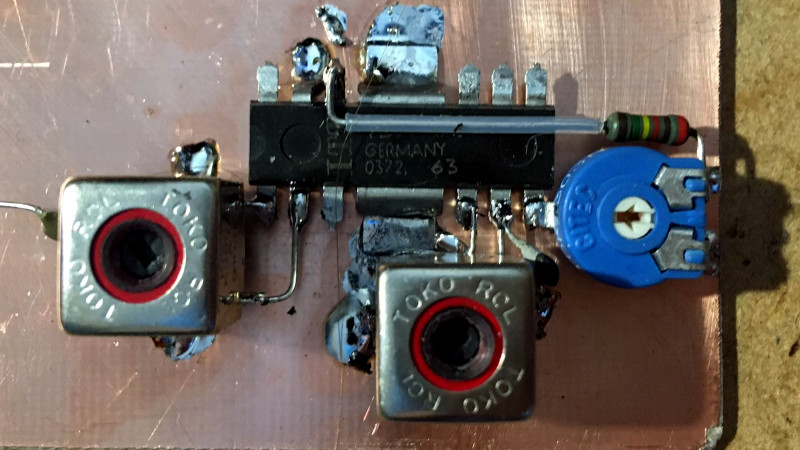It started with an old TV sound chip, and some curiosity. The TDA1701 that [Philip Bragg] found in a box of junk is a complete FM IF strip and audio power amplifier from the golden age of analogue PAL televisions, and while it was designed for the 5.5 MHz or 6 MHz FM subcarrier of European broadcast TV, he found it worked rather well at the more usual 10.7 MHz of a radio receiver. There followed a long thread detailing the genesis bit-by-bit of a decent quality VHF radio receiver, built dead-bug-style on a piece of PCB material.
The TDA1701 was soon joined by a couple of stages of IF amplification with a ceramic filter, and then by several iterations of a JFET mixer. A varicap tuned MOSFET RF amplifier followed, and then a local oscillator. Finally it became a fully-functional FM radio, with probably far better performance than most commercial radios. He admits tuning is a little impractical though, with what appears to be a cermet preset potentiometer covering the entire band.
We suspect this project isn’t finished, and we hope he posts the schematic. But it doesn’t really matter if he doesn’t, because the value here isn’t in the design. Instead it lies in the joy of creating an ad-hoc radio just for the fun of it, and that’s something we completely understand.
We’ve covered a lot of radios in our time, and while it might be the first to feature a TV sound chip, it’s not the first built on bare PCB.
















There isn’t much special for tv sound. I’m certain lots of FM IF strip ICs were designated for both TV and FM broadcast.
There was a narrow band FM 2M receiver detailed back in 1972 and I think the IF strip IC was for tv audio.
A lot of those ICs use a balanced mixer as the detector, so they can be reworked for AM, SSB, and CW reception.
This is beautiful! And not an Arduino in sight!
More like a dead beehive build with all those dead insects. Glorious circuit insanity (from an in awe Arduino geek).
OK, but I would like to see an article on building a discrete and reliable radio – preferably a transreciever . But not dependent on the Internet etc.
So that rules out SDRs. My interest is limited when I see that hard to get hold of components are used.
SDRs don’t depend on the internet, unless computing or integrated chips in general is included in the “etc”.
If you want to build something really discreet with no ICs you should probably look at the ham radio community.
Possibly vacuum tubes, if this is some kind of post EMP thing as one might infer from the “reliable” part.
How discreet it is probably depends more on your volume setting than the componenets you use.
Depending on the strictness of your definition all diy radio stuff tends to use at least some parts that aren’t exactly jellybean. Just the nature of the industry and RF electronics. That said the “QRP” (low power) side of ham radio is where you’ll find most of the minimalist homebrew stuff.
Dead bug style requires the IC to be on its back with its legs in the air.
Just saying.
Maybe right side up and splayed should be squashed bug style.